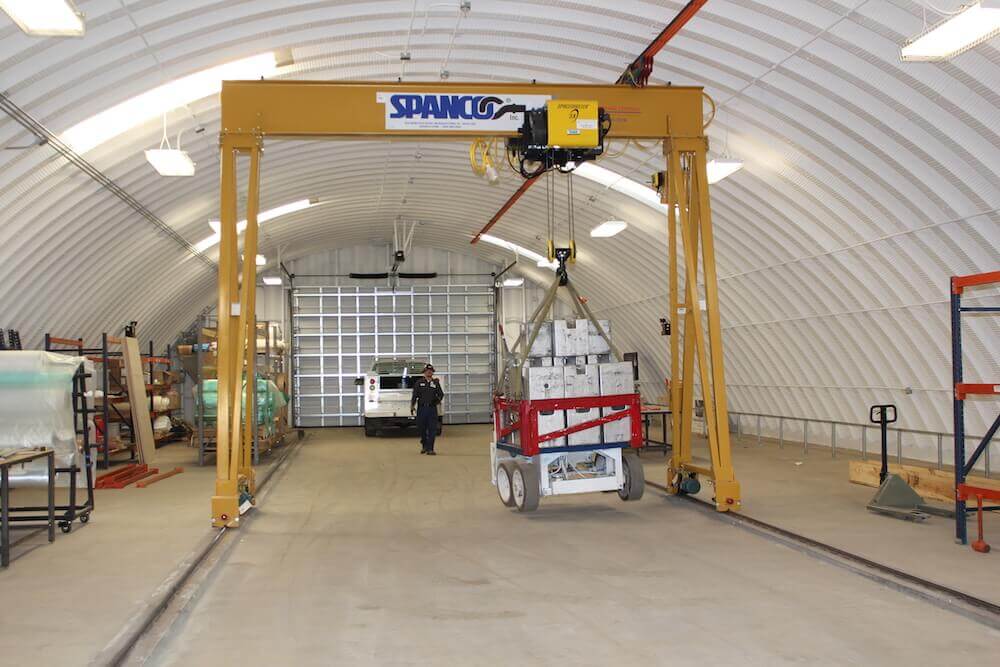How to Upgrade Individual Components of Your Overhead Crane

If you’re looking to expand the production capacity of your business, you may be considering a new overhead crane system.
But if you have a gantry or bridge crane, you can save money by upgrading individual components of your overhead crane instead of buying a brand new system.
From meeting OSHA safety standards to increasing your company’s production needs, there are several reasons to upgrade your overhead crane system.
Any of the following changes is process or production needs could be an optimal time to upgrade your overhead crane components:
- Lifting a new type of material
- Lifting a heavier type of material
- Making more frequent lifts
These changes can create extra wear on the individual components of your overhead crane system. And excess wear can lead to the premature failure of components, which can be unsafe and costly to repair.
But which components of your overhead gantry or bridge crane can be replaced? Here are the types of overhead cranes that are best suited for upgrades, and the individual components that can be upgraded to save you money on a complete replacement.
The Best Types of Overhead Cranes to Upgrade
Bridge and Gantry overhead cranes are the best types of overhead cranes for individual component upgrades. The components of these cranes can be interchanged without negatively impacting the overall design or functionality.
On the other hand, workstation cranes are usually designed with specialized components that are meant to work together. Beyond adding an additional track or upgrading the hoist, your workstation crane will more than likely need to be replaced if it can’t meet new production needs.
In the same way, Jib cranes are designed to meet a specific lifting and loading capacity. These cranes will need to be replaced to meet new capacity requirements.
What Components of the Crane Can Be Upgraded?
The crane experts at Crane Repair Co can evaluate your overhead crane’s mechanical, electrical, and structural components to determine if they’re capable of being upgraded.
The following crane components can be upgraded:
Build Up Hoists
- Many build up hoist components can be upgraded without having to replace your existing hoist and trolley.
- Accompanying parts like gear sets and motor may need to be replaced with more substantial parts to match the capacity of the new hoist.
- Lower-duty electric or pneumatic hoists come as a complete system, and need to be re-installed with a higher-capacity hoist package.
End Trucks and Wheels
- Your wheels can be upgraded to a harder material
- Make sure the wheels are made compatible with the crane’s rails and can handle heavier loads
- Bearings can be upgraded with an anti-friction design to reduce wear while increasing productivity demands.
Bridge, Runways, Structure
- The experts at Crane Repair Co can help determine if your crane’s bridge or runway girders needs extra reinforcement to support new wheel loads.
- The beams may need to be reinforced by adding a cap channel.
- You may need a specially-engineered plating for the existing bridge and runway beams to handle heavier loads.
- CRC will also perform a foundation survey to ensure the foundation and flooring of the building can support the crane’s new load requirements.
Controls
When the work of the motor changes, the drive system changes as well. Any changes to gear sets or motor size will require changes to the crane’s drive system and controls as well.
Adding in a modern control system, like a variable frequency drive, can provide smoother acceleration and deceleration—which eliminates abrupt starts and stops and helps prevent load sway. VFDs also help reduce wear and tear.
Modern-style radio controls also offer diagnostics and monitoring (off-site or on-site). Crane operators and production personnel can now use mobile devices, tablets, workstation computers, or an operator’s “belly box” to view real-time diagnostic data, including:
- Fault codes
- Number of lifts and cycles that the drives have made
- Capacity of lifts
- Maintenance requirements for certain components
- Amp draw and voltage
Electrification
- You can upgrade the size of the wiring in your overhead crane’s electrification system to accommodate higher amperage
- You can also upgrade the size of the electrification.
- If the new amperage requirements exceed the existing requirements in place, then a new disconnect equipped to handle higher amperage will be required to safely disconnect power from the crane equipment in the event of an emergency—according to OSHA 1910.179(g)(3)(i).
Brake Systems
- Once your crane is lifting and moving heavier loads, its original brakes may not be built to withstand the additional weight
- If you upgrade other components of your crane to support higher capacity, it’s a good time to replace your breaks so they can support the heavier load
Testing and Inspecting Your New Components
Before your company can get to work with your upgraded components, the crane will need to be load-tested to make sure everything is safe and functional.
Your new crane system will need to have 2 operational tests plus a rated load test before its first use.
These tests will check hoist operation, trolley and bridge travel, limit switches and more.
The goal for most crane upgrades is to prevent load swing. So adding in new acceleration and deceleration controls can take your team some time to get used to.
Let the professionals at Crane Repair Co get your overhead crane ready for your next project. Learn more about our certified, professional inspection services >










